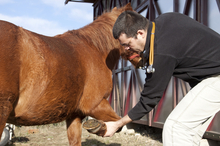Research has shown, and most veterinarians recognize, that the vast majority of laminitis cases are related to hormonal/endocrine disorders, specifically those involving insulin resistance. Avoidance requires diets very low in simple sugars (ESC) and starch, i.e., the components of the diet which cause an insulin rise (fructans do not elevate insulin).

Veterinarian checking horse for signs of laminitis
While it's true that regrowth of fall pastures and/or exposure to cold nights can raise the simple sugar and starch levels in grass, fall laminitis can, and does, strike horses which had no trouble handling spring pastures and horses with no access to pasture at all.
While it's true that regrowth of fall pastures and/or exposure to cold nights can raise the simple sugar and starch levels in grass, fall laminitis can, and often does, strike horses which had no trouble handling spring pastures and even many horses with no access to pasture at all.
Eleanor Kellon, VMD, veterinary advisor to ECIR Group Inc, explains. âThe typical case of fall laminitis is experiencing laminitis for the first time, or as a repeat of a previous fall episode. They are in their teens (or occasionally older) and owners report no change in diet or management. The cause is the seasonal rise in the hormone ACTH.â
ACTH is a hormone secreted by the pituitary gland. Its function is to stimulate the adrenals to release cortisol. Cortisol induces insulin resistance and also makes the blood vessels in the hoof more sensitive to chemicals mediating constriction.
âAll horses experience this seasonal rise in ACTHâ, said Kellon, âbut it can be much more pronounced in older horses, particularly those in the early stages of PPID (pituitary pars intermedia dysfunction â Cushing's disease) which may not yet be showing any obvious outward symptoms.â
The ECIR group has been following horses with hormonal disorders for over 15 years. In that time we have seen many horses whose first sign of PPID was an episode of fall laminitis. If your horse experiences this, have a talk with your veterinarian about testing for ACTH and PPID. The usual dietary measures are not enough when high levels of ACTH are involved. These horses require therapy with pergolide.
For more information on the seasonal rise in ACTH, Cushing's Disease and insulin resistance in horses visit www.ecirhorse.org and our outreach group at https://ecir.groups.io/g/main.
About ECIR Group Inc
Started in 1999, the ECIR Group is the largest field-trial database for PPID and IR in the world and provides the latest research, diagnosis and treatment information, in addition to dietary recommendations for horses with these conditions. Even universities do not and cannot compile and follow long term as many in-depth case histories of PPID/IR horses as the ECIR Group.
In 2013 the Equine Cushing's and Insulin Resistance Group Inc., an Arizona nonprofit corporation, was approved as a 501(c)3 public charity. Tax deductible contributions and grants support ongoing research, education, and awareness of Equine Cushing's Disease/PPID and Insulin Resistance.
THE MISSION of the ECIR Group Inc. is to improve the welfare of equines with metabolic disorders via a unique interface between basic research and real-life clinical experience. Prevention of laminitis is the ultimate goal. The ECIR Group serves the scientific community, practicing clinicians, and owners by focusing on investigations most likely to quickly, immediately, and significantly benefit the welfare of the horse.
